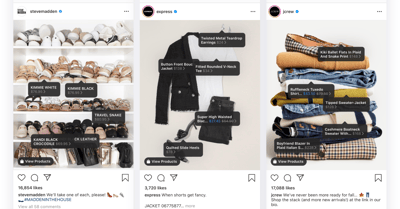Brands across the world have heard the new buzzword in the retail space: “unified commerce.” In this blog, we break down exactly what it means, why it’s often difficult to achieve, and why it’s the future of retail.
What is Unified Commerce?
Unified commerce is the practice of delivering a consistent and connected experience to shoppers across digital and physical channels. The objective is to enhance the customer’s shopping journey from product discovery to purchase across multiple channels like mobile, web, social, and physical stores.
Common Barriers to Adoption
Despite good intentions, retailers face a multitude of challenges that prohibit them from achieving a unified commerce experience.
- Channel-specific silos within the organizational structure. Instead of working as one business unit, online and physical stores are often in competition.
- Misguided decision-making. Many retailers fail to make strategic decisions based on observed customer shopping behaviors, instead letting general industry trends guide their actions.
- Lack of a clear policy on how inventory will be used to meet customer demand.
- Missing accurate and real-time visibility of all available inventory within the entire supply chain.
- Inability to process returns for online purchases in-store.
- Preserving inefficient, legacy systems that were designed for a single channel instead of investing in cutting-edge, omnichannel infrastructure.
- Fear of failure when it comes to implementing modern systems and protocols necessary for the multi-channel approach.
Paving the Way for Success
Fortunately, there are ways to overcome or eliminate these barriers in order to successfully provide your consumers with a true unified shopping experience. Below are just a few of our suggestions.
-
Restructure your organization to eliminate channel silos and unify the organization around a common, customer-centric goal. We recommend merging online and offline departments by eliminating divisional P&L and crediting your stores for online sales, regardless of whether store associates contributed to the generation of these sales.
-
Make real-time inventory (across the supply chain) available and transparent between internal teams and customers. Implement DOM (Distributed Order Management) that integrates with eCommerce, Point of Sale, and ERP to gain a single view of inventory. Using a DOM, retailers can publish their in-store inventory online and make sure that demand from any channel can be fulfilled using unsold inventory. For example, store associates can capture orders for out-of-stock products and fulfill them from DC. It also enables customer journeys like BOPIS (Buy Online Pick in Store), which bridges the gap between online and physical stores.
-
Gain a single view of the customer. Most customer data is managed from separate systems, like eCommerce, Point of Sale, Loyalty Engine, and Marketing Automation Software, that weren’t designed to communicate. This often creates a disjointed and inefficient ecosystem that damages your ability to provide a seamless shopping experience to your customers. We recommend implementing a CDP (Customer Data Platform) that integrates with all of these systems and delivers a single view of the customer to marketing, sales, and support teams. For example, suppose a registered online customer wants to place an order for an out-of-stock item in-store and get it shipped to their home address. Store associates would be able to use the CDP to pull the customer’s online profile and place the order for them instead of asking the customer to input all of this information again.
-
Modernise your stores and run them like eCommerce. Migrate from legacy POS (Point of Sale) to mPOS (Mobile Point of Sale, pre-integrated with DOM), because traditional POS systems are not built for today’s digital landscape. Traditional POS doesn’t support BOPIS (Buy Online Pick from Store), BORIS (Buy Online Return in Store), Endless Aisle, Clienteling, and mobile checkout with cashless payments. With Mobile POS, store associates can answer customers’ questions on the shop floor, check inventory instantly, and take orders on the spot.
-
Re-evaluate your eCommerce platform. To prepare for the future, migrate from a monolithic eCommerce platform to a headless commerce platform (pre-integrated with DOM). Headless commerce supports “multi-experience development,” meaning it is easier to re-build the UI for compatibility with multiple devices by reusing APIs. You can keep up with demand and release new channels without having to re-deploy or re-design your entire eCommerce platform. Modern consumers are shopping on mobile, social, voice commerce, wearables, and smart TV. Is your eCommerce platform built to handle these demand streams?
Retailers must scrap their legacy applications to move past their old, channel-restricted ways. Invest in channel-agnostic technology that can easily be integrated into your tech stack and deployed to your customers. That, coupled with a unified organisational structure, is a sure-fire recipe for success.
Why Now?
Why should unified commerce be a priority for your brand today? Simple: your competitors are already making moves. According to a Boston Retail Partners survey of the 500 top North American retailers, 81% will deploy a unified commerce strategy by the end of 2020. Many brands have been early adopters of this strategy, understanding the value of unification and establishing themselves as innovators within the retail space. For example, Walmart has met its 40% online growth goal for the 2019 fiscal year by implementing a unified approach.
According to a Gartner research study, online sellers that fail to implement a unified commerce strategy by 2025 will risk obsolescence. Simply put, your brand can’t afford to put unified commerce off any longer. Your competitors are quickly adopting these strategies to delight consumers across channels and geographies, and your future depends on your ability to keep up.
* * *
Now that you understand the value of unified commerce and unified commerce solutions, request a consultation with the HotWax Commerce team to discover our best-in-class solutions.









